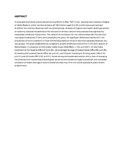Health seeking and hygiene behaviours predict nutritional status of pre-school children in a slum area of Addis Ababa, Ethiopia.

View/
Date
2000Author
Abate, G
Kogi-Makau, W
Muroki, N M
Type
ArticleLanguage
enMetadata
Show full item recordAbstract
A cross-sectional study was conducted during March to May 1997 in four selected slum kebeles (villages) of Addis Ababa in which nutritional status of 758 children aged 6 to 36 months was examined and stratified into malnourished and well nourished groups. Analysis of hygiene and health seeking practices of randomly selected households of the two sets of children determined practices that significantly exacerbate childhood malnutrition. The rates of immunization for the malnourished (80.2%) and well nourished households (77.6%) were practically the same. No significant difference was found in the prevalence of home treatment or food withholding habits at times of diarrhoea episodes between the two groups. The study established six variables to predict childhood malnutrition in the slum section of Addis Ababa: (1) presence of child waste inside house (Odds Ratio =7.44; p<0.0001), (2) diarrhoea treatment at the hospital (OR=0.47;p<0.05), (3) prolonged storage of cooked foods (OR=2.86; p<0.05), (4) feeding with washed hands (OR=0.44; p<0.01), and (5) poor handling of drinking water (OR=3.18; p<0.01) and (6) foods (OR=3.52; p<0.01). Hence strong and sustainable advice with a view of changing the behaviours of households towards good personal and household hygiene practices, and increased utilization of health settings is recommended as these may limit the overall success of public health programmes.
URI
http://www.cabdirect.org/abstracts/20003028340.html;jsessionid=3EC2337C99394A65AA21AEC57FE0DA65http://erepository.uonbi.ac.ke:8080/xmlui/handle/123456789/54335
Citation
Ethiopian Medical Journal 2000 Vol. 38 No. 4 pp. 253-265Publisher
University of Nairobi Department of Food Science, Nutrition & Technology
